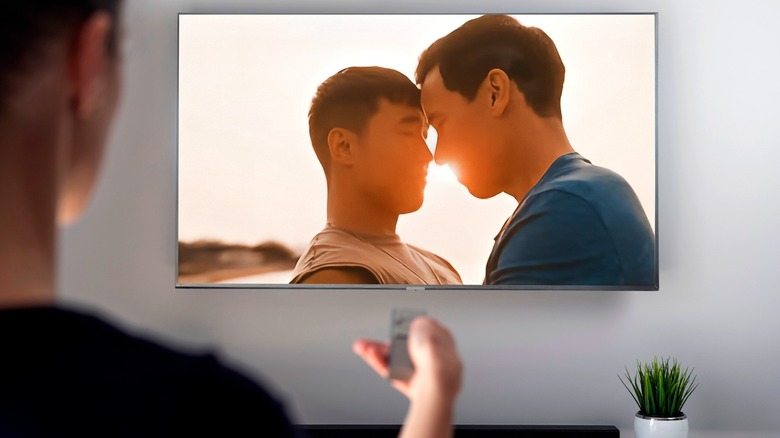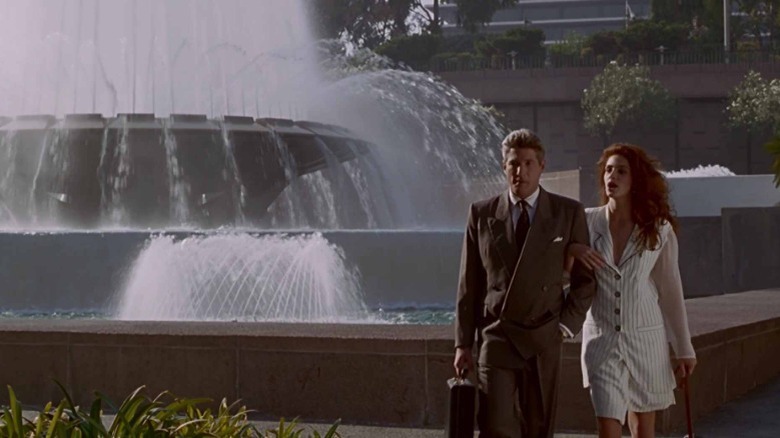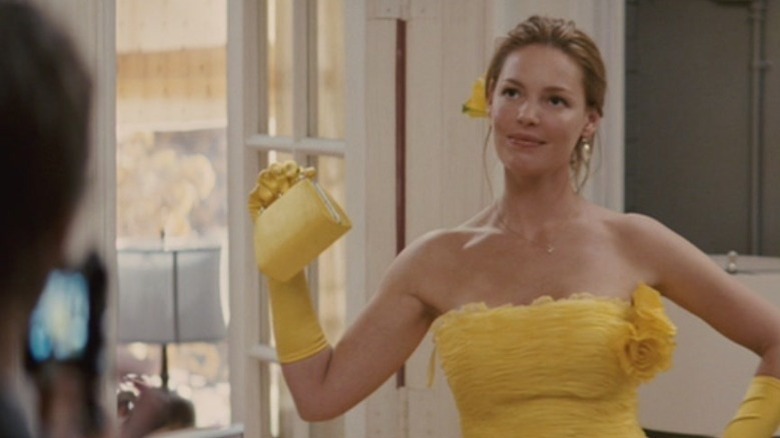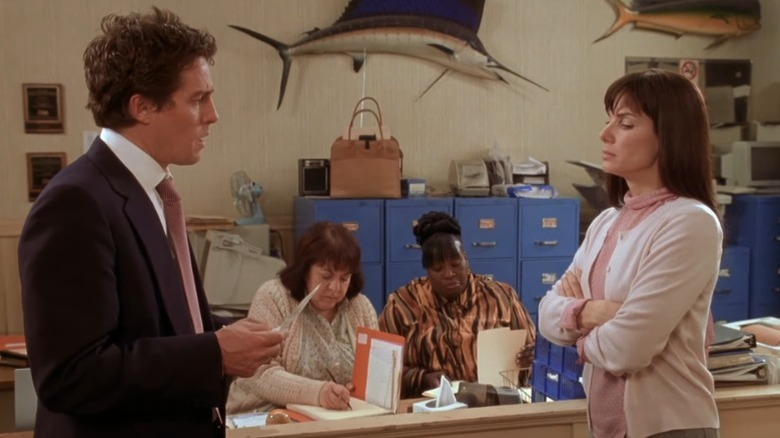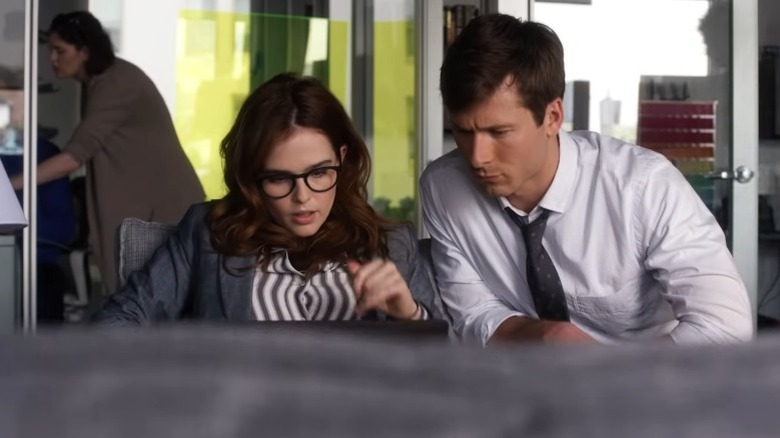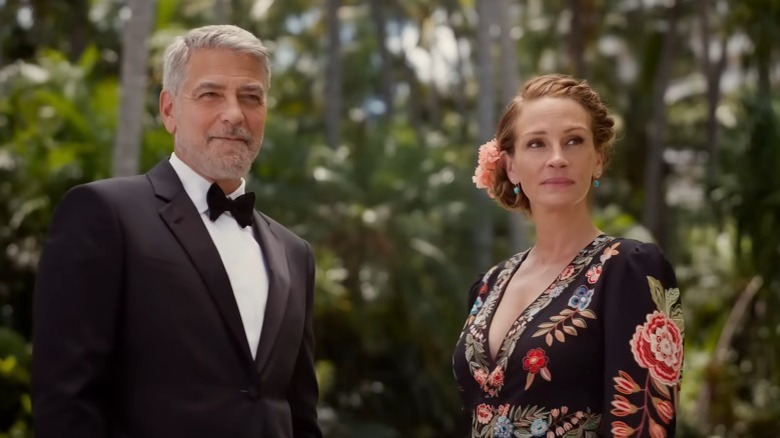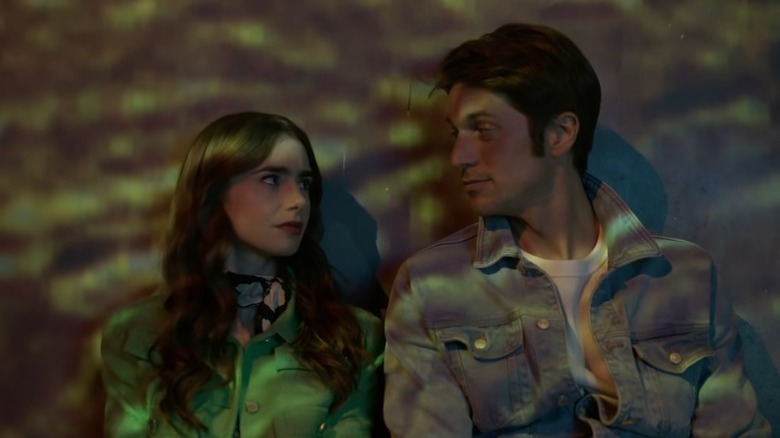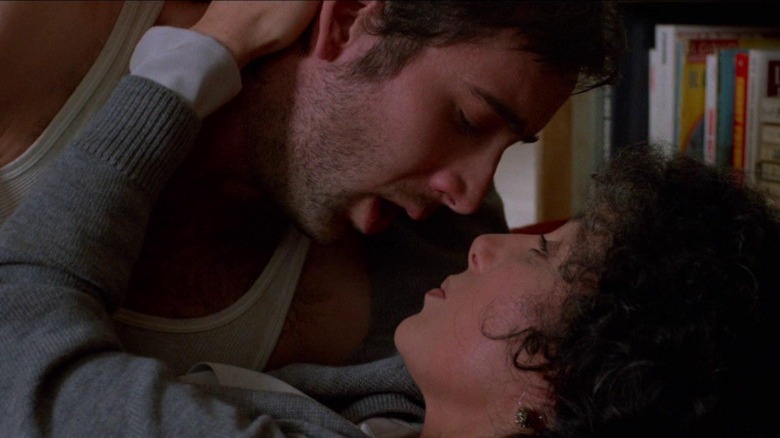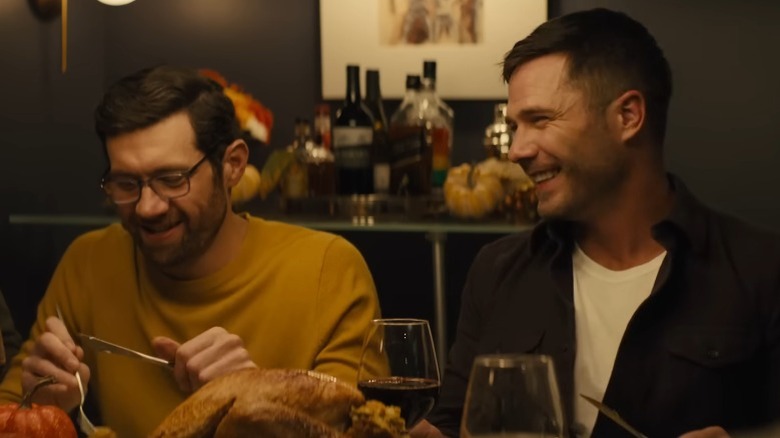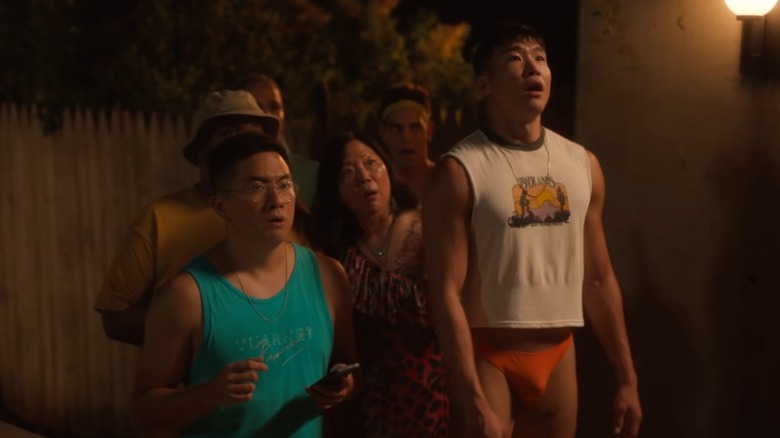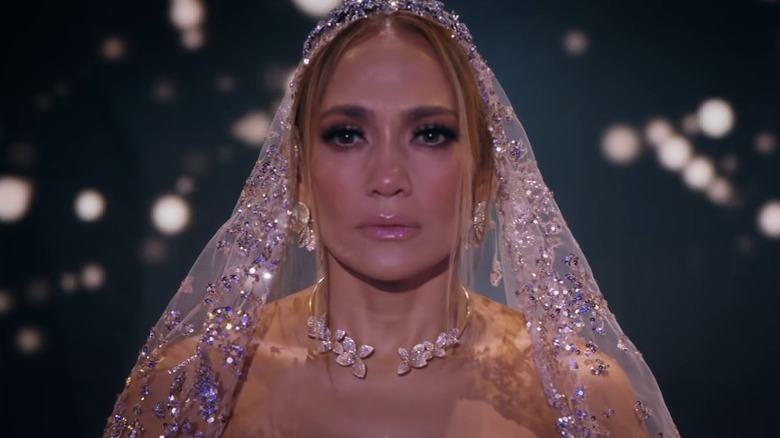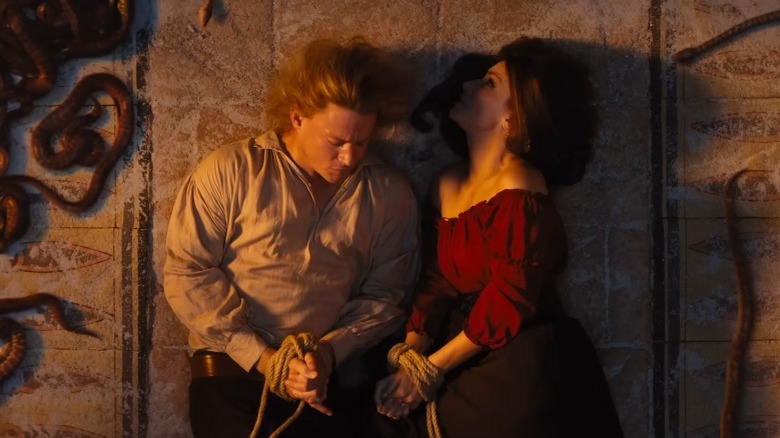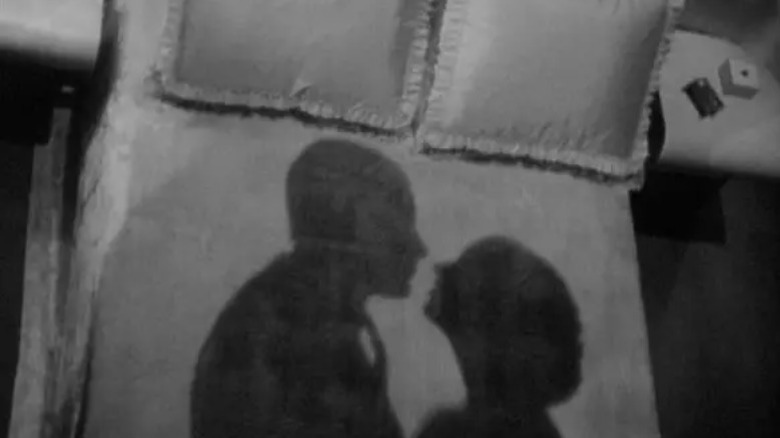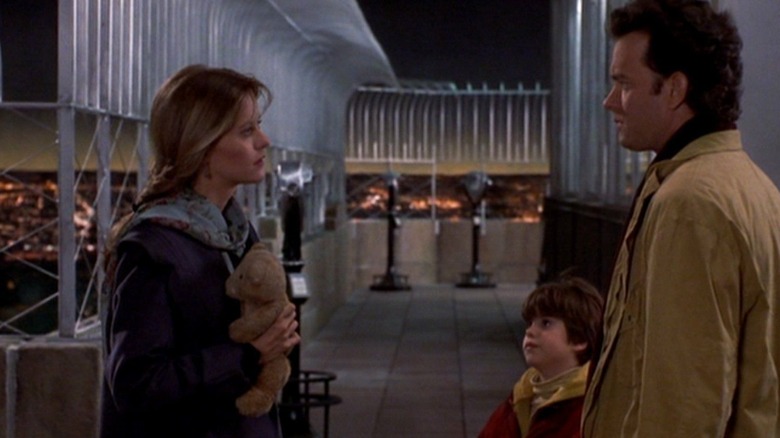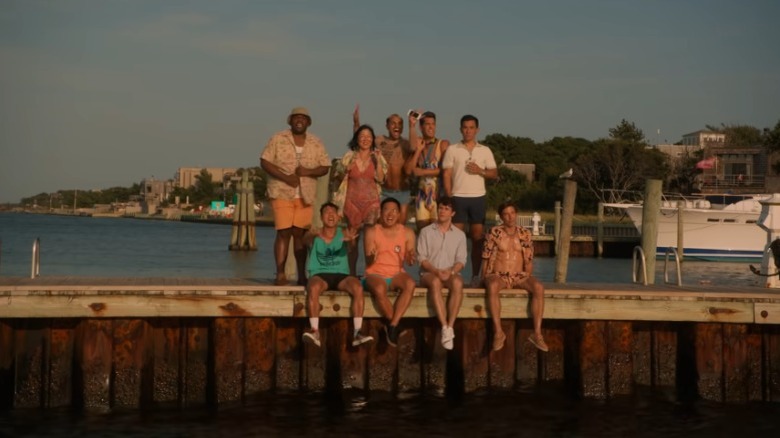Rom-Coms Can Kiss And Make Up With Audiences, But They Need To Get Some New Techniques
Hollywood is always on the lookout to detect and get on top of the trends brewing within its own complex and ever-unstable alchemy, and in the past couple of years, it would seem that the industry has caught on to a resurgence in the public's interest in an old, storied genre: the romantic comedy.
As recently as 2018, the rom-com landscape was so barren in theaters that Netflix heads could give interviews openly talking about how the streamer was putting out numerous rom-coms a year because they weren't being made anywhere else. Since then, though, enough successes have proven that the genre is no longer the exclusive business of streaming services in the contemporary film economy. First off, "The Lost City" was a bonafide megahit, drawing crowds into multiplexes for weeks and weeks on end during the spring of 2022. "Ticket to Paradise" and "Marry Me" both struck a chord with filmgoers by betting on the old, still reliable device of bringing in a duo of beloved superstar actors to headline the cast. Best of all, "Fire Island," "Bros," and "Crush" evinced the growing market for LGBT-centric rom-coms, and streaming titles like "The Valet," "Meet Cute," and "Shotgun Wedding" showed just how much the audience for the genre is spread across various consumer profiles.
All signs would seem to point to a reconciliation between rom-coms and audiences after several years of a strained relationship — but, if that's to happen, there are several ways in which the industry needs to step up to the plate.
Rom-coms used to be a staple of the theatrical experience
There was a time, not so long ago, when going to the nearest movie theater to watch whatever's out that looks good wasn't such a rare, once-in-a-blue-moon occurrence. In those days — roughly predating the emergence of the "franchise era," such as it is — a movie didn't have to financially justify itself as a cultural option for adults with dough and time to spend. The element we now have of "Well, I better get my money's worth for this!" was moot, so long as the film itself was enjoyable. That being the case, there was no expectation that "theater-worthy movies" should be ones with lavish special effects, astronomical production values, and physically jolting entertainment on par with a theme park ride. Any movie could be seen and enjoyed in a theater by millions of spectators, so long as it provided them with fun. And the most purely fun of all non-blockbuster movie modes, arguably, was the rom-com.
Boasting attention-grabbing concepts and mesmerizing movie stars in the leading roles, the typical Hollywood romantic comedy could be many things: A breezily enjoyable romp, an experience in classic empathetic dramaturgy as filtered through light and consistent genre forms, or an escape into a fantasy realm where sweeping, soul-soothing love was actually achievable ... more than anything, it was the most reliable way Hollywood had of bringing adults into theaters to watch normal, relatable stories about regular humans living their lives (give or take a credibility-straining airport run).
The market for rom-coms shrank along with all mid-budget popular cinema
The tide began to turn for rom-coms around the mid-2000s, roughly concurrently with the film industry's broader shift in production and release patterns. As Hollywood began to realize that profits could be multiplied exponentially if studios put more of their money into massive blockbuster productions with built-in brand interest, the market slowly grew to be absolutely dominated by franchise tentpole films. That shift, combined with a general decline in week-to-week film theater attendance across the United States and around the world, led to a situation in which viewers, more and more, grew accustomed to not showing up for films in theaters unless they were franchise tentpoles. And, when streaming opened up yet another avenue, allowing movie fans uninterested in blockbusters to not even have to leave their homes to have access to their preferred content, the production pipeline became even narrower.
What this meant was a drying up of funds for all kinds of mid-budget, adult-oriented films not falling into either the "hundred-million-dollar mega-release" or "boutique indie Oscar hopeful" brackets — and rom-coms were arguably the genre most affected by that new reality. With the industry having backed itself and audiences into the expectation that expensive spectacle was the only thing that could possibly get people to buy increasingly costlier theater tickets, there remained little reason to continue putting out films that, like a typical rom-com, were populist and mass-friendly without really having any hope of making studios upwards of hundreds of millions of dollars.
Rom-coms were also affected by a cultural shift
That "billion or bust" mentality affected all adult-oriented genres, but rom-coms were doubly screwed over by what seemed like a growing lack of a well-defined place for them in contemporary pop culture. For many years, rom-coms were thought of as "chick flicks" — i.e., films primarily aimed at an audience of women, and somehow niche for that reason. Although rom-coms going back to the 1930s were often among the most progressive and socially uproarious films put out by Hollywood, at their heart, for decades and decades, lingered a nugget of obstinate romanticism that seemed to get more and more out of fashion in times of increasing popular skepticism towards traditional, idealized conceptions of love and marriage.
Beginning in the 1990s and even more so in the 2000s, a phenomenon of "gender-conscious" romantic comedies began to emerge, with heroines who had bustling professional, artistic, and intellectual lives in tandem with their romantic pursuits — but even those films were ultimately predicated on the question of whether or not the girl gets the guy, or vice-versa. And, eventually, that inevitable place all rom-coms returned to was no longer such an easy one for audiences to square with their own lives and values.
At the turn of the 2010s, rom-coms largely stopped being guaranteed economic bets. Films that would once have been surefire money-makers, from "How Do You Know?" to "Leap Year," yielded increasingly underwhelming returns. In response, the rom-coms still being made began to veer in the direction of genre deconstruction and skepticism — which, although responsible for a momentary wave of hits like "Friends with Benefits," also contributed to an increased public perception that rom-coms as a whole were a relic of a different time.
Eventually, the rom-com niche was filled again by streaming
This all brings us to the current landscape. First, as mentioned above, streaming services took notice of the fact that studios weren't rising up to audiences' desire for lighthearted romantic entertainment, and began to put out copious amounts of rom-coms every year — and while some, like "Set It Up" and "To All the Boys I've Loved Before," managed to stand out from the glut and become genuine cultural events, a vast amount of the titles in the "rom-com" sections of various streaming libraries just kind of disappeared into the content ether.
While this trend proved to studio heads that the desire for rom-coms was still there — and the massive theatrical success of "Crazy Rich Asians" made that fact too conspicuous to ignore — it also convinced many a financier that audiences longed for rom-coms on streaming. Which translated to: cheap, painfully generic, featuring moderately known yet affordable stars, and able to be churned out of an assembly line. Thus, the streaming rom-com boom somehow furthered the decline of rom-coms as a relevant cultural force.
Thankfully, it also encouraged some producers of theatrical film to once again put stock in the potential of a good rom-com to draw audiences into theaters. In the post-COVID resurgence of film production, this renewed faith ultimately led to the veritable wealth of rom-com goods we got in 2022. And those rom-coms can give us a few pointers for the future.
Fixing rom-coms step #1: Establish new stars
Looking at the recent slate of rom-coms, both theatrical and streaming-bound, a few things stand out.
First among them: Just as in the 1990s and the 1940s, stars are still indispensable tools in a successful rom-com's arsenal. "The Lost City" would absolutely not have climbed to its staggering $100-million-plus intake if it weren't for the combined superpowers of Sandra Bullock and Channing Tatum. A subpar effort like "Marry Me" could still save itself from cultural and economic oblivion and make itself widely seen by front lining personalities as big and idiosyncratic as Jennifer Lopez and Owen Wilson. And "Ticket to Paradise," of course, staked its claim for the public imagination as "the Julia Roberts and George Clooney movie."
This points to the first problem rom-coms have to solve if they are to truly come back — new stars are needed, stat. Brilliant and charismatic as they may be, the old guard of reliable romantic leads can't secure the genre's financial viability forever. There are multiple, widely-analyzed reasons why Hollywood has all but stopped producing bona fide movie stars in the last 15 years or so, beginning with the decline of the midbudget bracket and the growing emphasis on brands and franchise arch-narratives. But, whatever the causes, the fact remains that rom-coms cannot subsist without a deep bench of the kind of transfixing, outsized screen personalities who can turn a slap to the face into certified movie magic.
Rom-com films need to measure up to their TV competition
In addition to the basic problem of finding and establishing new A-list movie stars who can lord over the box office just with the prospect of seeing sparks fly between them — something especially crucial if rom-coms are to rebuild a "middle range" of moderately successful entries, which are arguably more relevant to a genre's long-term sustenance than the big mega-hits — there's also the question of what a cinematic, theatrical romantic comedy can offer viewers in 2023 that they can't just as well find on TV.
Like most non-effects-driven pop cinema genres, the rom-com quietly migrated to television over the course of the 2010s: it was the decade of Jess and Nick, of Leslie and Ben, of Kurt and Blaine, of Mindy and Danny, and so on. The simultaneously shorter and longer time investment of TV — consumable in minutes at a time, yet capable of developing narrative buildups and payoffs over years — has turned out to be particularly gainful for rom-coms, which are essentially predicated on that very nexus between passive escapism and sincere investment.
Now, if movies are to find their way back into the hearts of rom-com lovers, they need to find a way to play to that same nexus. This means providing the same sense of frothy, effortless, brain-massaging fun as sitcoms, while also inspiring, in the span of 90 minutes, the same degree of character attachment that TV shows do over the course of whole seasons.
Rom-coms need to fall back in love ... with love itself
Which, of course, begs the question — how exactly can a movie pull off the wondrous feat of stoking investment without straying from escapism? For many years, rom-coms achieved that balance by two means: First, by grappling directly with the relationship anxieties of modern adults, so that everyone could see themselves in the characters' conundrums. Second, by following a playbook of reliable genre tricks.
Then, in the 2000s, as a general cultural cynicism took hold of America, the sense of romantic optimism and genuine interest in the machinations of love that once animated rom-coms became a rare quantity among writers and audiences alike, leaving only the tricks to keep the boat afloat. During their nadir of the late 2000s, it wasn't uncommon for mainstream romantic comedies to feel bizarrely arbitrary, like they themselves didn't believe in their own meet-cutes and grand gestures and climatic speeches as anything more than boxes being ticked.
Therefore, corny as it may sound, it is imperative that rom-com films start believing in love again. Writers and directors must find their own clear ideas about what love is, what it means, what it begets, and why it's the greatest agony and greatest glory a person can experience in their life — and they must be able to persuade audiences of those ideas. And, with the way society's ideas about love have changed, a complete structural overhaul of the rom-com playbook may be in order too.
Contemporary love is more interesting for its unconventionality
The fact that love and relationships look dramatically different in the 21st century does not at all mean that they have ceased to exist as a cultural force worth examining and telling stories about. In fact, as great romantic storytellers going all the way back to Jane Austen have taught us, the more skeptical and deconstructionist a society's views on love are, the more urgently the quest for it manifests in the soul.
Sure, we're no longer in the 1940s, when heterosexual matrimony as the be-all-end-all of life was such a universal cultural given that movies didn't even have to explain their faith in it. We're not in the 1980s, with its considerations about women's ability to "have it all" bespeaking an almost naive optimism about the aspirational greatness of marriage and capitalism alike. We're living in the 2020s, a time when, for many, marriage feels less and less like an economically or emotionally viable proposition, the dating scene is an algorithm-corrupted hellscape, the unspoken rules of cis-heteronormative courtship have been exposed as malarkey, the reality of trauma as a byproduct of toxic relationships has become culturally inescapable, and the very concept of monogamy is called into question every day.
But does any of that mean that people have stopped falling in love and moving mountains to be together? Absolutely not. As a matter of fact, love is even more interesting now that it perseveres through all that, taking on such varied, fluid, specific forms.
The structure of rom-coms needs to change to reflect love's new, messier forms
One of the standout titles from last year's rom-com-palooza, "Fire Island," aptly demonstrates the ways in which the difficulty of understanding and pinning down contemporary love ought only to enrich, rather than limit, new iterations of the genre. And it's no coincidence that the film is a loose adaptation of "Pride and Prejudice." Much like Austen herself, writer and star Joel Kim Booster understood that, if we live in alienating, isolating, traumatizing times when the entire belief system that regulates what we've traditionally called "love" can be said to be a cruel, classist, reactionary, patriarchal fraud, that only compounds our desire for the kind of affirming and soul-soothing connection provided by loving and being loved in return.
The film's defiance of traditional rom-com structure, by foregrounding an ironclad platonic friendship and letting the romantic entanglements develop as a result of the mutual understanding, compassion, and support afforded by that friendship, points to the way in which romantic comedies will need to evolve if they are to make sense of love in its current forms. If the particular experience of queer Asian men, for instance, couldn't fit into the linear, uncomplicated, individualistic boy-meets-girl mold of traditional straight and white love stories, then let the mold be broken — let love be scattered, resented, questioned, debated amongst peers, and ultimately hard-earned the way it is for people like Noah (Booster) and Howie (Bowen Yang) in real life.
Our current world is teeming with untold rom-com stories
The same principle can be applied to all forms that humans have found of continuing to make love work in our messy times. For one thing, "Fire Island" reminds us of the resilience of queer people, who for centuries and centuries have persisted in finding ways to access the joys of companionship in the face of a world that does its best to deny it to them. This makes queer love stories, much more than just a specific "niche" to be explored, a key territory for the "new" romantic comedy to venture into and draw wisdom and inspiration from.
Even beyond the spectrum of queer romance, though, love as practiced in our days can and should give rise to a variety of new configurations within the rom-com genre. For instance, between social media, COVID, and refinements in videoconferencing technology, long-distance relationships have become as vital a part of millions of people's lives as traditional, physical dating — and still haven't been really explored by cinema, notwithstanding editing's singular ability to subordinate physical distance to psychological experience. The same can be said for polyamorous arrangements, which have their own delicate complexities and intense emotional challenges and rewards, but have seemingly been barred from movies by screenwriters' logistical difficulty to balance more than two protagonists. Heck, even run-of-the-mill open relationships have become common enough to transform traditional conversations about commitment and cheating — but when have we seen writers map narrative conflict to those relationships' rules and tensions?
The possibilities for new high-concept rom-com hooks are endless
With how hectic and unpredictable relationships can be nowadays, romantic comedy writers could also be looking at the greatest wealth of potential concepts in human history. Every rom-com, after all, is a high-concept movie at heart: there's nary a notable example of the genre that doesn't bind its romantic journey to some kind of strong dramaturgical hook, some ready-made conflict that sets it apart from the competition. Absent the limitations imposed on the characters by conventional rom-coms and their various tacit moral rules, the sky is the limit to the fascinating, hilarious, and pulse-pounding situations that creatives can come up with as the foundation for new projects set in the modern dating world.
This, like the fostering of new A-list stars, is of the essence in the "next step" that rom-coms are to take beyond the banner year of 2022. Sure, films like "The Valet," "Ticket to Paradise," and "Marry Me" had solid hooks — but they largely followed the formula of "unlikely pair thrust into living and working together until they actually fall in love." That formula is just one option. Anyone dating in 2023 has stories, or knows stories, about relationships born from not living and working together, from doing one without the other, from being forced apart, from wanting to be together and not managing, from seeking each other out repeatedly, from falling in love and then out of it. The possibilities are endless, really, and the genre needs to live up to them.
The sensibility of romantic comedies can be a flexible tool
As if there weren't enough possible ways to operate a reinvention in the realm of, shall we say, "pure" romantic comedy, the thundering success of "The Lost City" serves as a reminder of a particular characteristic of rom-coms that has allowed them to endure for so long as a prime pop genre, and that should be given due attention in any plans for their industrial future: their flexibility. Rom-coms are not just an insulated, open-and-shut genre. They're also a sensibility that can be applied to any number of filmic modes.
Even before "The Lost City," "Shotgun Wedding," and other recent crossover hits like "Spontaneous" and "Mamma Mia! Here We Go Again," audiences had been taking a liking to such wildly varied propositions as the action rom-com, the adventure rom-com, the musical rom-com, and even the horror rom-com for decades. The basic principle of "characters falling in love in a fun, escapist context" can occupy the center of any kind of film, really — and, with every new genre that rom-com writers branch out to, the narrative possibilities become even more expansive.
For instance, we have yet to see a full-fledged, truly committed superhero rom-com, even if "Deadpool" and "Thor: Love and Thunder" came close. While we're at it, a big-budget animated comedy putting the romance front and center has been pretty much unheard-of since the first "Shrek." Once again, it's all a matter of where imagination takes writers.
Rom-coms have to go back to a cinematic visual sensibility
Speaking of which, a lot of the responsibility for revitalizing a genre always seems to fall on that same group before anyone else — the writers. Which, in a genre as character-driven as the rom-com, is quite understandable. But, if you look at the history of romantic comedies, the fact clearly emerges that screenwriting is but one of the elements that make a great romantic comedy sing. In any conversation about where the genre should go in the future, therefore, some responsibility needs to be apportioned to the directors.
This is, of course, because one of the great industrial sticks in the craw of all 2023 rom-coms is the public assumption that they are not "cinematic" enough to be worth going to theaters for. If television has become the genre's prime domain, even rom-coms taking the form of feature films have largely defaulted to a TV-like visual sensibility over the past couple of decades. Netflix's play for dominance in the "rom-com film" niche has aggravated the issue, as an absurd numerical chunk of the feature rom-coms being made nowadays have been conforming to the streamer's woefully bureaucratic all-purpose visual sensibility determined by filming tech and house style guidelines.
In light of that, it's hard to argue against fans who would rather — who would only — watch rom-coms in the comfort of their homes, thereby further limiting the market prospects of new productions in the genre. But it really doesn't have to be this way.
The great rom-com directors have shown the way
The visual and aural vocabulary of most contemporary rom-coms can be described, by and large, as functional: Basic coverage, straightforward shot-reverse-shot clarity, shallow focus, sets and locations de-emphasized. But the great rom-com directors have all shown that the genre doesn't have to conform to such schematism.
Dorothy Arzner knew as much when she made the characters' elaborate burlesque choreography as crucial to their romantic self-expression as the dialogue proper in "Dance, Girl, Dance." Preston Sturges knew it when he intercut a climatic reveal scene in "The Lady Eve" with ironic inserts of train bells and whistles. Billy Wilder knew it when he carefully timed a certain Shirley MacLaine reaction shot in "The Apartment" for maximum emotional devastation. Nora Ephron knew it when she let the melancholy shades of nighttime lighting set the mood in "Sleepless in Seattle." Even Nancy Meyers, so underestimated as a formalist, gave her films a degree of texture and lived-in authenticity by emphasizing interior design that so many of today's entries in the genre seem to lack. These filmmakers have understood that films are not just scripts read aloud — they are experiences in tone, immersion, atmosphere, setting, spectacle, music, and timing.
Rom-coms, in particular, can be snapshots of geography, community, fashion, cuisine, urban customs, social mores — the characters and their stories ring truer and more affecting the more vividly the world they're in comes across. To reassert their worth as specifically cinematic experiences, rom-coms need to bring all of that back to the table.
Rom-coms have never been more important
What matters, more than anything, is that everyone working in the rom-com genre, from writers to designers to casting directors to the helmers overseeing it all, should keep in mind what they can be doing — and hold that as the standard for what they should be doing. From the dawn of movies as we know them, romantic comedies have been cinema's utmost province of unfettered human exuberance, in its rawest, most vibrant, most uplifting forms. No other film genre out of all the ones that have been invented in the past century is so specifically driven by the basic appeal of goodness — of kind gestures, of heartfelt declarations, of people making an obstinate effort to be together and better each other's lives, hardships be damned.
At a time when the world seems bleaker, more confusing, more uncertain, more individualistic, and less kind than it has been in ages, the importance of stories about our collective capacity to have fun, enjoy each other's company and support, and give ourselves over to love in all its forms has never been greater — nor have the possible avenues for such stories ever been more varied. Like Austenian heroines, we persist in a bitterly absurd universe, and love still finds us. Like a bunch of friends vacationing on Fire Island, we find ways to connect amidst the bustle. So let films reflect the process by which we do, even if the process demands change of them as it does of us.
